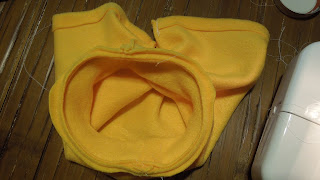There is no pattern for the insert you see pictured, but it is easy to draw up your own template. This diaper as pictured also holds a newborn prefold trifolded, with another insert stuffed inside it. I have used this template to sew AIOs, AI2s, fitteds, and hybrid fitteds. If you are using a stretchy material (such as a knit and/or micro fleece), this diaper will fit slightly larger.
I have included basic sewing instructions right on the template. I have only made this diaper using the turn and top stitch method but you should be able to serge as well, if you make adjustments for the seam allowance, and round off the edges. I prefer to tack my elastic, but I have also done rolled elastic and it has worked out mostly okay (the inside layer gets a bit funky but there is no noticeable difference when the baby is wearing it).
I prefer the side snapping diaper for a few reasons. Firstly, wing droop is nonexistent. Secondly, I feel it's easier to get a more custom fit- the waist and legs can be adjusted independently of each other.
A note on the template: the dots on each piece indicate where the snaps are to be placed. You place the studs on the front piece and the sockets on the back part with the wings, the opposite of a front snapping diaper. I generally sew this with about a half inch seam allowance, although I've never been picky about that and it doesn't seem to have mattered too much. Also, if you hate applying snaps (I really, really do), this pattern works fairly well as a closureless diaper using a Snappi. If you are going to try that I would recommend extending the length of the wings slightly, as the fit is just a wee bit tighter. I am experimenting with making the wings wider, as well, as wing droop is definitely more of an issue with the front closure version.
These two pieces run right to the edges of the page where they connect. Simply cut them out and tape together. I like to trace onto heavier poster board for continued use.
Thanks for looking! Let me know what you think.
Sammy's Side Snapping Diaper Templates





















